1996 PONTIAC BONNEVILLE warning light
[x] Cancel search: warning lightPage 187 of 387
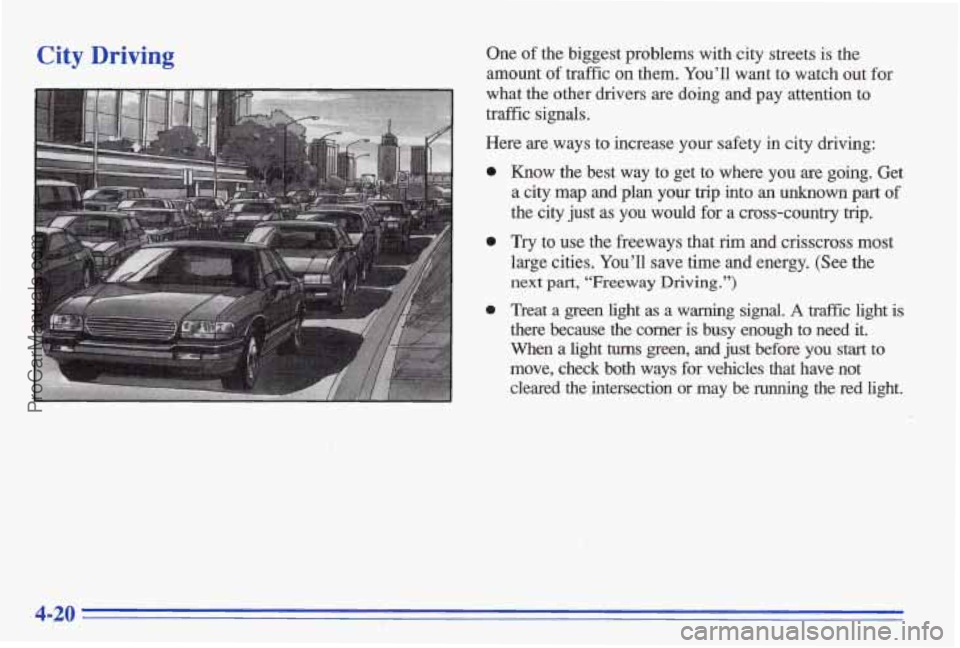
City Driving One of the biggest problems with city streets is the
amount of traffic
on them. You’ll want to watch out for
what the other drivers are doing
and pay attention to
traffic signals.
Here are.ways to increase your safety
in city driving:
0
a
Know the best way to get to where you are going. Get
a city map and plan your trip.into an unknown part of
the city just as you would for a cross-countq trip.
Try to use the freeways that rim and crisscross most
large cities.
You’ll save time and energy. (See the
next part, “Freeway Driving.”)
Treat a green light as a warning signd A traftic light is
there because the corner is busy enough to need it.
When
a light huns green, and just before you start to
move, check both ways for vehicles that have not
cleared
the intersection or may be running the red light.
4-20
ProCarManuals.com
Page 192 of 387
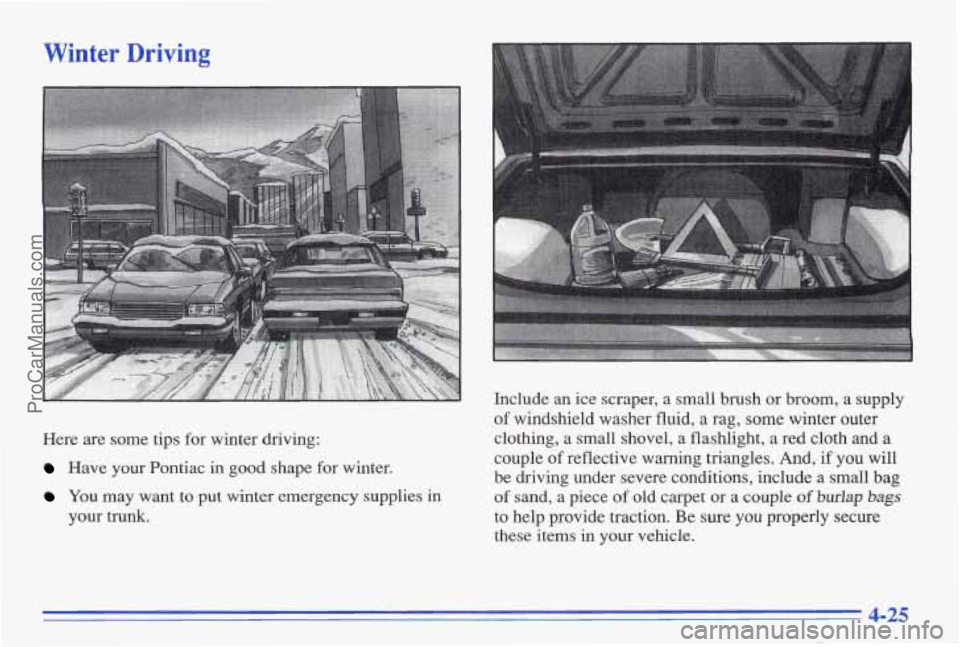
Winter Driving
Here are some tips for winter driving:
Have your Pontiac in good shape for winter.
You may want to put winter emergency supplies in
your trunk. Include an ice scraper, a small brush or broom, a supply
of windshield washer fluid, a rag, some winter outer
clothing, a small shovel, a flashlight,
a red cloth and a
couple of reflective warning triangles. And, if you will
be driving under severe conditions, include .a small bag
of sand, a piece of old carpet or a couple of burlap hgs
to help provide traction. Be sure you properly secure
these items in your vehicle.
4-25
ProCarManuals.com
Page 204 of 387

Making Turns
NOTICE:
Making very sharp turns while trailering could
cause the trailer to come in contact with the
vehicle. Your vehicle could be damaged. Avoid
making very sharp turns while trailering.
When you’re turning with a trailer, make wider turns than
normal. Do this so your trailer won’t strike soft shoulders,
curbs, road signs, trees or other objects. Avoid jerky
or
sudden maneuvers. Signal well in advance. ‘
. Turn ,Signals When Towing a Trailer’
When you tow a trailer, your vehicle may need a
different
turn signal flasher and/or extra wiring. Check
with your Pontiac dealer. The green
arrows on your
instrument panel will flash whenever you signal a turn
or lane change. Properly hooked up,’ the trailer lamps
will also flash, telling other drivers you’re about to turn,
change lanes or stop. When towing a trailer, the green arrows
on your
instrument panel will flash for turns
even if the bulbs on
the trailer are burned out.
Thus, you may think drivers
behind you are seeing your signal when they are not. It’s
important to check occasionally to be sure the trailer
bulbs are still working.
Your vehicle has bulb warning lights. When you’plug
a trailer lighting system into your vehicle’s lighting
system, its bulb warning lights may not let you
know if
one of your lamps goes out. So, when you have a trailer
lighting system plugged in, be sure to check your
vehicle and trailer lamps
from time to time to be sure
they’re
all working. Once you disconnect the trailer
lamps, the bulb warning lights again can tell you
if one
of ypur vehicle lamps is out.
Driving On Grades
Reduce speed and shift to a lower gear before you start
down a long or steep downgrade.
If you don’t shift
down, you might have to use your brakes so much that
they. would get hot
and no longer work well.
On a long uphill grade, shift down to Dm (D) and
reduce your speed to around
45 mph (70 km/h) to reduce
the possibility of engine and transaxle overheating.
4-37
ProCarManuals.com
Page 220 of 387
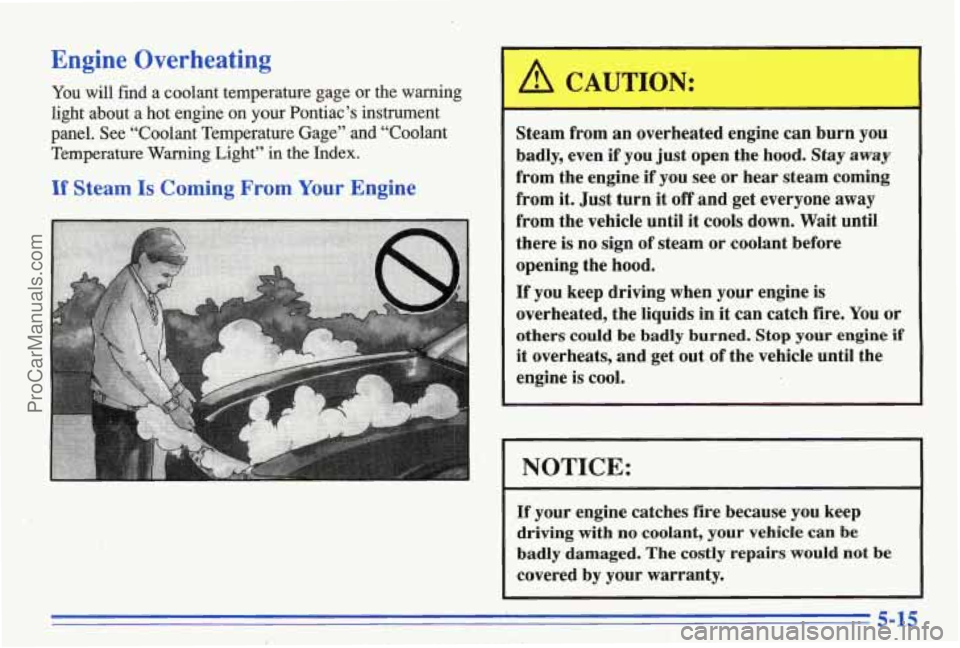
Engine Overheating
You will find a coolant temperature gage or the warning
light about a hot engine
on your Pontiac’s instrument
panel. See “Coolant Temperature Gage” and “Coolant Temperature Warning Light” in the Index.
If Steam Is Coming From Your Engine
I
Steam from an overheated engine can burn you
badly, even if you just open the hood. Stay
away
from the engine if you see or hear steam coming
from it. Just turn it
off and get everyone away
from the vehicle until it cools down. Wait until
there is no sign of steam or coolant before
opening the
hood.
If you keep driving when your engine is
overheated, the liquids in it can catch fire. You
or
others could be badly burned. Stop your engine if
it overheats, and get out of the vehicle until the
engine is cool.
I
NOTICE:
If your engine catches fire because you keep
driving with no coolant, your vehicle can be
badly damaged. The costly repairs would not be
covered
by your warranty.
5-15
ProCarManuals.com
Page 267 of 387

How to Add Fluid
Refer to the Maintenance Schedule to determine what
bind of tmhsaxle fluid to use. See 6‘Recomended
Fluids and Lubricants” in the Index.
If the fluid level is low, add only enough of the proper
fluid to bring
the level into the cross-hatched area on
the dipstick.
Pull out the dipstick.
Using a long-neck funnel, add enough
Md at the
dipstick hole to bring it to the proper level. It doesn’t
take much
fluid, generally less than a pint (0.5 L).
Don’t overfiI2. We recommend you use only fluid
labeled
DEXRON*-III,, because fluid with that label
is made especially for yo& automatic transax18e.
Damage caused
by fluid other than DEXRON’@-III
is not covered by your new vehicle warranty.
After adding fluid, recheck the fluid level as
described under “How to Check.”
When the correct fluid level is obtained, push the
dipstick back in
all the way.
Engine Coolant
The cooling system in your vehicle is filled with new
DEX-COOL (orange-colored,
silicate-free) engine
coolant.
This coolant is designed to remain in your
vehicle for 5 years or 100,000 miles (166 000 km),
whichever occurs first.
The following explains your cooling system and how to
add coolant when it is low.
If you have a problem with
engine overheating, see “Engine Overheating” in
the Index.
A 50/50 mixture of water &d the proper coolant for
your Pontiac will:
e
e
0
0
0
Give freezing protection down to -34°F (-37°C).
Give boiling protection up to 265 OF (1 29 O C).
Protect against rust and corrosion.
Help keep the proper engine temperature.
Let the warning lights and gages work as they should.
ProCarManuals.com
Page 274 of 387

your brake system fixed, since a leak means that sooner
or later your brakes won’t work well, or won’t work
at
all.
So, it isn’t a good idea to “top off’ your brake fluid.
Adding brake fluid won’t gorrect a leak.
If you add fluid
when your linings are worn, then you’ll have too much
fluid when you get new brake linings. You should add
(or remove) brake fluid, as necessary, only when work
is
done on the brake hydraulic system.
If you have too much brake fluid, it can spill on
the engine. The fluid will burn if the engine is hot
enough.
You or others could be burned, and
your vehicle could be damaged. Add brake
fluid only when work is done on. the brake
hydraulic system.
When
your brake fluid falls to a low level, your brake
warning light will come on. A chime will sound if you
try to drive with this warning light on. See “Brake
System Warning Light” in the Index. What
to
Add
When you do need brake fluid, use only DOT-3 brake
fluid
-- such as Delco Supreme 11 @ (GM Part
No. 1052535). Use new brake fluid from a sealed
container only, and always clean the brake fluid.
reservoir cap before removing it.
XLUTION:
-
With the wrong kind of fluid in your brake
system, your brakes
may not work well, or they
may not even work
at all. This could cause a
crash. Always use the proper brake fluid.
ProCarManuals.com
Page 291 of 387
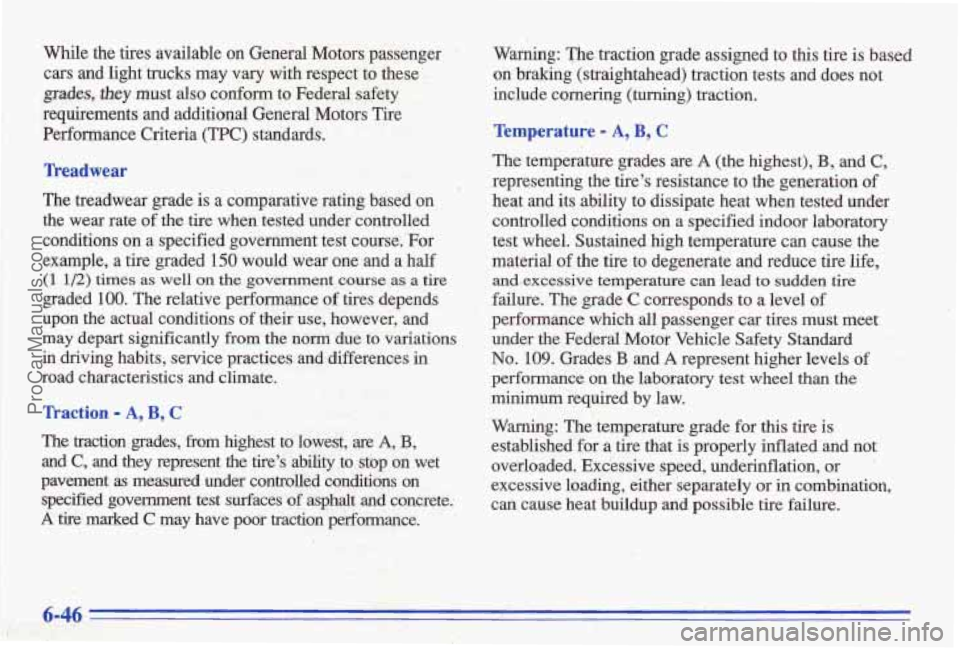
While the tires available on General Motors passenger .
cars and light 'trucks may vary with respect to these
grades, they must also conform to Federal safety
requirements and additional General Motors Tire
Perforrnance Criteria (TPC) standards.
Treadwear
The treadwear grade is a comparative rating based on
the wear rate of the tire when tested under controlled
conditions on a specified government test course. -For
example, a tire graded
150 would wear one and a half
(1 1/2) times as well on the government course as a tire
graded 100. The relative performance
of tires depends
upon the actual conditions
of their use, however, and
may
depart significantly from the norm due to variations
in driving habits, service practices and differences
in
road characteristics and climate.
Traction - A, B, C
The traction grades, from highest to lowest, are A, B,
and C, and they represent the tire's ability to stop on wet
pavement
as measured under controlid conditions on
..? specified government test surfaces of asphalt and concrete.
- A tire'marked C may have poor traction performance.
I
.~. .-I -
. I. . I .,. .. - -. ,. . . .. , .. 1. . , ;::-;.,;:,> ::; ,? ..';;Y, i ... . . ~ ~.:.:..-*,,~'.v ;,, - .%$ -,r- '.: '. . , -.; =,,,-, .-. *. :-,- =.: ; .,
Y1.Y. .r.
Warning: The traction grade assigned to this tire is based
on braking (straightahead) traction tests and does not
include cornering (turning) traction.
Temperature - A, B, C
The temperature grades are A (the highest), B, and C,
representing the tire's resistance to ,the generation of
heat and its ability to dissipate heat when tested under controlled conditions on
a specified indoor laboratory
test wheel. Sustained high temperature can cause the
material
of the tire to degenerate and reduce tire life,
andaxcessive temperature can lead to sudden tire
failure. The grade C corresponds to a level of
performance which all passenger car tires must meet
under the Federal Motor Vehicle Safety Standard
No. 109. Grades B and A represent higher levels of
performance on the laboratory test wheel than the
minimum required by law.
Warning: The temperature grade for this tire
is
established €or a tire that is properly inflated and not
overloaded. Excessive speed, underinflation, or
. '
excessive loading, either separately or in combination,
can cause heat buildup and possible tire failure.
6-46
ProCarManuals.com
Page 375 of 387
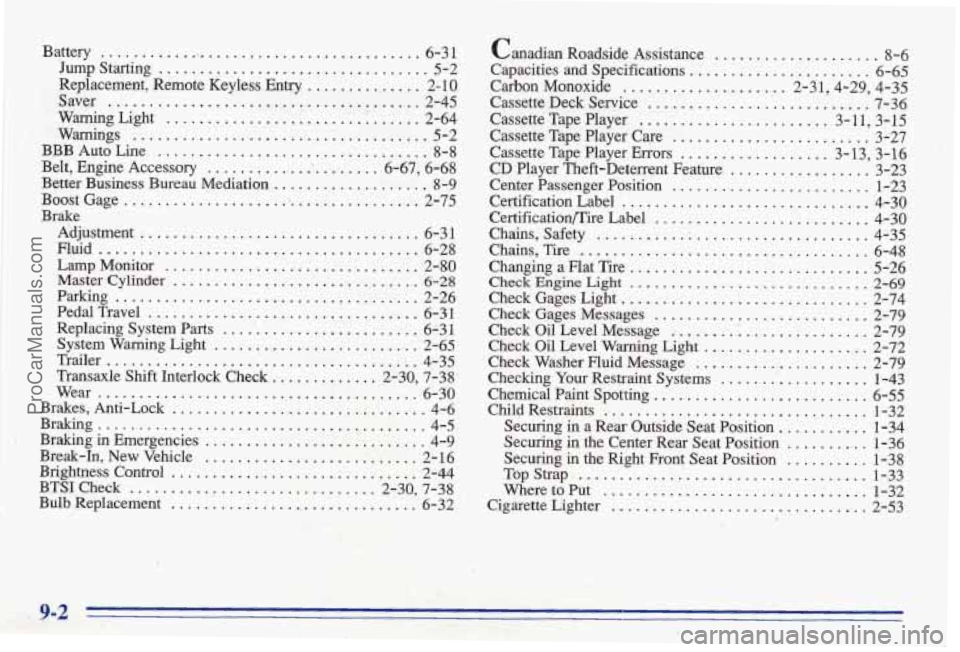
Battery ........................................ 6-3 1
Jump Starting ....... ! ......................... 5-2
Replacement. Remote Keyless Entry
.............. 2- 10
Warning Light
............................... 2-64
BBB Auto Line
................................. 8-8
Better Business Bureau Mediation ................... 8-9
BoostGage
.................................... 2-75
Adjustment
.................................. 6-3 1
Fluid
....................................... 6-28
Lamp Monitor
............................... 2-80
Master Cylinder .............................. 6-28
Parking ..................................... 2-26
Replacing System Parts
........................ 6-3 1
System Warning Light
......................... 2-65
Transaxle Shift Interlock Check
............. 2-30. 7-38
Brakes. Anti-Lock ............................... 4-6
Braking ........................................ 4-5
Braking in Emergencies ........................... 4-9
Break-In. New Vehicle .......................... 2- 16
Brightness Control
.............................. 2-44
BTSI Check
.............................. 2-30. 7-38
Bulb Replacement .............................. 6-32
Saver
.........'............................. 2-45
Warnings
.................................... 5-2
Belt. Engine Accessory
...................... 6-67. 6-68
Brake
PedalTravel
................................. 6-31
Trailer ...................................... 4-35
Wear
....................................... 6-30
Canadian Roadside Assistance .................... 8-6
Capacities and Specifications
...................... 6-65
Carbon Monoxide .................... 2-31.4-29. 4-35
Cassette Deck Service
........................... 7.36
Cassette Tape Player ....................... 3- 11 . 3-15
Cassette Tape Player Care ........................ 3-27
Cassette Tape Player Errors
.................. 3.13. 3.16
CD Player Theft-Deterrent Feature ................. 3-23
Center Passenger Position
........................ 1-23
Certification Label
.............................. 4-30
CertificationRire Label .......................... 4-30
Changing a Flat Tire ............................. 5-26
Check Engine Light ............................. 2-69
Check Gages Light
.............................. 2-74
Check Gages Messages
.......................... 2-79
Check Oil Level Warning Light .................... 2-72
Check Washer Fluid Message ..................... 2-79
Checking Your Restraint Systems
.................. 1-43
Chemical Paint Spotting
.......................... 6-55
Child Restraints
................................ 1-32
Securing
in a Rear Outside Seat Position ........... 1-34
Securing in the Center Rear Seat Position .......... 1-36
Securing in the Right Front Seat Position
.......... 1-38
Where to Put
................................ 1-32
Cigarette Lighter
............................... 2-53
Chains. Safety
................................. 4-35
Chains. Tire
................................... 6-48
Check Oil Level Message ........ ............... 2-79
TopStrap
................................... 1-33
9-2
ProCarManuals.com